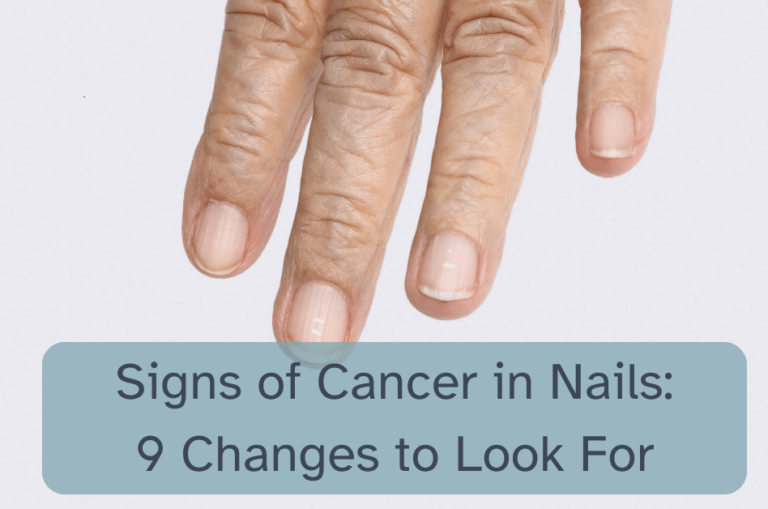
It’s common to hear reminders to check the breasts or testicles for signs of cancer, but did you know you should also check for signs of cancer in your nails? Your nails can be windows into your internal health. Changes in your nails can signal a number of conditions, from low levels of certain vitamins in your system to more serious conditions, such as cancer.
New lines, colors and dark areas on the nail and the skin around the nail should signal you to schedule an appointment with a dermatologist to have it checked out.
Remember, not all nail problems mean it’s cancer. But it’s important to check out areas of concern, just in case you’re seeing early signs of skin cancer. Early diagnosis and treatment lead to much a higher survival rate if it is caught at an earlier stage of cancer.
Melanoma
Melanoma is one of the types of skin cancer that can be found in and around the fingernails and toenails, among other parts of the body. Melanoma is the deadliest form of skin cancer, which is why it’s so important to keep an eye out for any changes in your nails.
The good news is, melanoma on the hands and feet is rare, only around 4% of cases are finger or toenail melanoma, and it is highly treatable when found early.
These types of melanoma are not related to sun exposure or continued sun damage, like most other types of skin cancer are.
Melanoma starts when melanocytes, which are a type of skin cell responsible for skin pigment, becomes cancerous. There are a few different types of nail cancer:
- subungual melanoma starts underneath the nails in the nail matrix, where keratin forms
- ungual melanoma develops underneath the nail plate and
- periungual melanoma, which starts in the skin next to the nail plate
Acral lentiginous melanoma is a malignant melanoma that starts on the palms and soles of the feet. Since these areas are so close to the nails, this can spread to the nails, leading to a cancerous toenail or fingernail.
Subungual Melanoma
This is the most common melanoma of the nail. The latest research shows that this is is the most common type of melanoma among African American, Asian and Hispanic ethnic groups.
Signs of subungual melanoma and other nail cancers include:
- brown line or black bands that aren’t caused by an injury to the nail. These are most commonly seen on the thumb or big toe, but can develop on any nail. These brown-black discolorations of the nail bed is one of the most common symptoms of this type of cancer
- dark streaks in the nail plate, or a dark line running down the nail that grows over time indicate a need to h
- toenails or fingernails that separate from the nail bed. The white edge at the top of your nail will look longer as the nail lifts
- dark skin around the nail, especially if it continues to darken or spread
- a nail that bleeds
- a nail that splits down the middle
- a bump underneath the nail
- a nail turning white or yellow, or developing a strange texture can also be reason for concern.
Also, a condition called finger clubbing or nail clubbing is something to also keep an eye out for. This is typically associated with more advanced stages of lung cancer or other internal cancers, and involves swelling of the fingers and nails curving downward.
Examining Signs of Cancer in the Nails
A dermatologist is the best type of doctor to evaluate your nails, since this can be so rare, your regular doctor may not know what to look for.
In the physical examination, the doctor will examine not just the affected area, but all of your nails, and the skin around the nails. They’ll first rule out other causes of nail problems, like a fungal infection.
A full skin exam may also be done. Moles, which are collections of melanocytes, need to be looked at to see if any of them appear to have cancer cells. Most moles are not cancerous, but checking both your skin and nails will help the dermatologist make an accurate diagnosis.
Something called a full-thickness biopsy of the nail bed may be done, which is where a piece of your entire nail, both above and below the affected area will be removed and the nail cells examined for cancerous cells.
Your health care team will discuss the results of the biopsy with you and help you to decide what type of treatment, if any is needed.
A common early treatment for different types of nail-related melanoma is to remove the entire nail and growth. More advanced cases may be treated with radiation therapy, chemotherapy or immunotherapy. In severe cases, amputation may be required.
Ongoing Self Checks for Signs of Cancer in Your Nails
It’s important to regularly check for signs of cancer in your nails, particularly if you have a family history of melanoma.
Noticeable nail changes including nail color, texture, or shape may alert you to potential health issues, including skin cancer.
Don’t dismiss unusual spots at the base of the nail, a black streak or skin changes around your nails as just cosmetic concerns – they could indicate that a doctor should take a closer look.
Early detection is key. Malignant melanomas, those cancerous cells that have spread to other areas of the body are the hardest to treat, so it’s best to catch it early if at all possible.
Stay familiar with the appearance of your nails and talk to your doctor if you notice any of the above changes. Again, these are rare cases, but it doesn’t hurt to be proactive about this part of your health.



